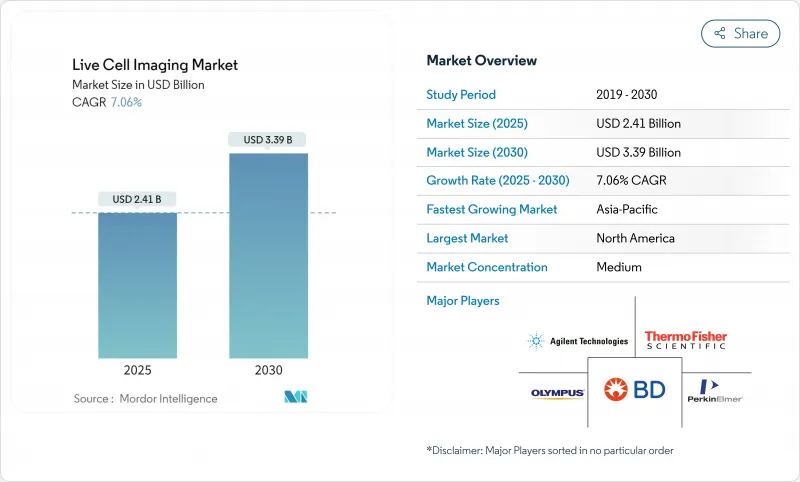
|
市場調査レポート
商品コード
1851700
ライブセルイメージング:市場シェア分析、産業動向、統計、成長予測(2025年~2030年)Live Cell Imaging - Market Share Analysis, Industry Trends & Statistics, Growth Forecasts (2025 - 2030) |
||||||
カスタマイズ可能
適宜更新あり
|
|||||||
| ライブセルイメージング:市場シェア分析、産業動向、統計、成長予測(2025年~2030年) |
|
出版日: 2025年07月11日
発行: Mordor Intelligence
ページ情報: 英文 135 Pages
納期: 2~3営業日
|
概要
ライブセルイメージング市場規模は2025年に24億米ドルに達し、2030年には33億9,000万米ドルに達すると予測され、期間中7.06%のCAGRで進展します。

人工知能(AI)と統合されたハイコンテントスクリーニング(HCS)プラットフォームの普及、腫瘍学および免疫学研究に対する資金提供の強化、標準的なインキュベーター内に収まる小型化された装置が、この拡大を総体的に支えています。製薬会社は、ナノスケールの解像度を維持しながら画像取得サイクルを40%短縮するAI対応イメージング・システムを導入することで、前臨床試験のタイムラインを短縮し、ヒト初臨床試験までの時間を短縮しています。同時に、ホロトモグラフィのようなラベルフリーのモダリティは、研究者が蛍光剤なしでオルガノイドをリアルタイムで観察するのに役立ち、光毒性の懸念を軽減し、細胞生理を数週間維持します。競合の動きは、純粋な光学機器から、ハードウェア、ソフトウェア、クラウドベースの分析を融合させたエンド・ツー・エンドのソリューションへとシフトしており、顕微鏡のバリューチェーン全体で戦略的提携や標的を絞った買収を促しています。地域別では、北米は確立された資金調達手段と製薬企業の密集地であることから、引き続きライブセルイメージング市場で最大のシェアを占めているが、アジア太平洋地域は、各国政府がバイオテクノロジーへの投資を奨励し、規制を調和させていることから、現在最も急成長しています。
世界のライブセルイメージング市場の動向と洞察
ハイコンテンツスクリーニングプラットフォームの進歩
ハイコンテント・スクリーニング・システムは現在、機械学習アルゴリズムを統合し、1ウェルあたり数千の表現型変数を数分で解析し、かつては数日を要した従来のエンドポイントアッセイに取って代わる。2025年1月に発売されたMolecular DevicesのImageXpress HCS.aiプラットフォームは、複雑な細胞表現型を95%の精度で分類する一方、解析時間を60%短縮しています。製薬チームは、このようなスループットを活用して化合物ライブラリーを迅速に反復し、初期の探索予算を最大40%削減し、併用療法の探索にリソースを割くことができます。同じ自動化により、オルガノイドベースの精密医療がサポートされ、患者由来の腫瘍モデルが、数十の薬剤候補に対して並列試験を受けることで、手作業の画像ワークフローではコスト的に不可能であったオーダーメイドの治療経路が明らかになります。
がん・免疫学研究費の急増
2024年、議会の予算により研究財源が拡大し、高度なイメージングへの需要が高まる。米国国立がん研究所は、2024会計年度に72億2,000万米ドル(2023会計年度比1億2,000万米ドル増)を受け取り、イメージングツールの技術革新に大幅な予算を計上しました。2025年、米国国防総省は前立腺がんイニシアチブに6億5,000万米ドルを割り当て、ここでも光学診断とリアルタイムの細胞モニタリングに焦点を当てた。これらの資金は、アカデミックコアでの調達サイクルを加速し、ライブセルイメージングを助成金提案における標準的なプラクティスとして位置づけ、免疫と腫瘍の相互作用をコホート間で比較するために整合化されたイメージングプロトコルに依存する多施設試験を促進します。
高い取得・維持コスト
AIを組み込んだ高度な共焦点顕微鏡や格子状光シート顕微鏡は、通常50万~150万米ドルで販売されており、サービス契約により毎年購入価格の10~15%が加算されます。消耗品、特殊培地、マイクロプレート、環境チャンバーは、多忙な基幹施設では年間5万米ドル以上になることもあります。新興市場の検査室では、関税や不安定な為替レートのために20-30%の割増料金を支払うこともあり、助成金予算が伸び、アップグレードが遅れます。その結果、共用装置モデルが普及するが、時間枠の制約により、科学者は実験デザインやスループット目標を妥協せざるを得なくなり、市場浸透が阻害されます。
セグメント分析
2024年のライブセルイメージング市場の44.10%を機器が占め、ライブセルイメージング市場規模の約10億6,000万米ドルに相当します。横河のCQ3000のようなシステムは、共焦点、明視野、位相コントラストモードを1つの筐体に統合しており、アッセイ設計者はサンプルを移動することなく各モダリティ間を行き来することができます。ハードウェアに組み込まれたクラウドベースの解析機能により、テラバイト単位の画像をほぼリアルタイムで解析し、手作業によるバッチ処理キューを排除します。一方、ラベルフリーホロトモグラフィー用に最適化されたメディア、マイクロパターンマルチウェルプレート、蛍光色素安定化バッファーなどの消耗品は、CAGR7.89%という急速な速度で進歩しています。ベンダーは、長期間の照明下でも細胞生理を維持できるよう試薬を調整しており、これまではpHや酸素濃度のドリフトに悩まされていた1週間程度のオルガノイド研究にとって重要です。ソフトウエアは最も小さな金額だが、生の画像スタックを実用的な表現型に変換するAIモジュールのロックを解除するため、戦略的な影響力を持っています。アルゴリズムのアップデートに連動したサブスクリプション・ライセンシングにより、ベンダーはハードウェアが飽和した後でも継続的な収益を確保することができます。
第二のダイナミズムは、小型化です。ライカのベンチトップ型Mica Microhubは、温度とCO2の調整、環境適応型オートフォーカス、AIセグメンテーションを、従来の広視野リグよりも65%小さいフットプリントで実現しています。このようなコンパクトさは、混雑したインキュベーター通路のスペースを解放し、バイオセーフティレベルの環境への展開を容易にします。かつて2台の顕微鏡を稼働させていたラボが、今では6台の顕微鏡を稼働させ、それぞれに専用のチャンバースライドやキャリブレーションキットを必要とするかもしれないです。複数の機器にまたがるフリート管理をオーケストレーションするソフトウェア・スタックが必須となり、カテゴリーがさらに混在するようになります。
細胞生物学は、ゲノミクス、プロテオミクス、代謝研究において基礎的な役割を果たすことから、2024年の売上高の28.45%を占めました。研究者は、加齢研究に関連した代謝ストレスモデル下で、細胞骨格の再編成、ミトコンドリアの動態、オートファジーのフラックスを観察するためにライブセルイメージングを利用しています。しかし、創薬はCAGR 8.52%と最も高く、2030年までにライブセルイメージング市場シェアの大部分を占めることになります。製薬グループは、オルガノイドの共培養と高コンテンツ分析を組み合わせ、AIスクリーニングファネルに供給する表現型が豊富なデータセットを生成しています。このアプローチにより、毒性負債を早期に発見することで、前臨床のヒットからリードへの段階での消耗を削減しています。
幹細胞や発生生物学の使用事例も、分化経路の縦断的イメージングを必要とする再生医療パイプラインに後押しされ、増加しています。ホロトモグラフィーによって、研究者は、組織特異的な構造を検証するために極めて重要な、外来性標識なしで臓器スケールの形態形成を3Dで可視化することができます。がん免疫学では、T細胞を患者由来の腫瘍オルガノイドと共培養して免疫シナプス形成を定量化し、免疫療法の投与レジメンを導いています。神経生物学の最前線では、皮質オルガノイドのシナプス発火パターンをミリ秒単位ではなく数分単位でマッピングする100フレーム/秒のスキャナーと組み合わせたカルシウム指標色素が役立っています。
ライブセルイメージング市場レポートは、業界を製品別(装置、消耗品、ソフトウェア、サービス)、用途別(細胞生物学、発生生物学、幹細胞生物学、創薬、その他の用途)、地域別(北米、欧州、アジア太平洋、中東、南米)に分類しています。5年間の市場予測とともに5年間の過去データを入手できます。
地域分析
北米は2024年の売上高42.23%でライブセルイメージング市場をリードしており、これはNIHと国防総省の助成金によって支えられています。一流大学では、多施設でのがん臨床試験の競争力を維持するため、HCSを定期的に更新しています。FDAの積極的な姿勢は、2025年1月の光イメージング医薬品に関するガイダンスの草案で明らかであるが、規制を明確にすることで、セラノスティックイメージングに焦点を当てた商業的研究開発のスピンアウトに拍車をかけています。マサチューセッツ州、カリフォルニア州、オンタリオ州にある大規模な製薬会社は、サプライヤーを中心に集積し、機能展開を加速させる迅速なフィードバックループを育んでいます。しかし、カテゴリーをリードする研究機関のほとんどがすでに第2世代のAI対応顕微鏡を運用しているため、成長は頭打ちとなっています。今後の売上は、新規設置よりも買い替えやソフトウェアライセンスの拡大に傾きます。
アジア太平洋地域のCAGRは9.20%を記録すると予測され、これは世界最速です。日本は2028年までに民間バイオテクノロジー資本を倍増させ、2030年までに15兆円規模のバイオテクノロジー経済を目指します。ロードマップでは、細胞治療の商業化に向けた柱としてイメージング・インフラを特に挙げています。中国は、新しいCGT製造パーク内にGMPグレードのイメージング・スイートを拡張し、現地のエレクトロニクス能力を利用してサブアセンブリを製造し、コストを抑えます。ASEANの医療機器規制の調和により、国境を越えた調達の障壁が低くなり、シンガポールを拠点とするCROは、標準化された画像処理プロトコルで地域の臨床試験に対応できるようになります。
欧州は、ドイツ、スイス、英国の製薬多国籍企業を中心に、強固な設置基盤を維持しています。Horizon-Europeの助成金は、汎大陸コンソーシアムを奨励し、すべてのコンソーシアムは、再現性を確保するために、統一されたイメージング・プラットフォームを導入しなければならないです。環境スチュワードシップ・イニシアチブは、EUのグリーン・ディール目標に合わせて、水銀灯に比べて消費電力を最大30%削減するLED照明システムを奨励します。画像バイオマーカーに関する欧州医薬品庁(European Medicines Agency)の協議は、コンパニオン診断開発に向けたハードウェア投資をさらに正当化します。GDP成長率が鈍化しているにもかかわらず、研究ランキングで画像処理能力が重視されるようになっているため、改修サイクルは健全なままです。
その他の特典:
- エクセル形式の市場予測(ME)シート
- 3ヶ月間のアナリストサポート
よくあるご質問
目次
第1章 イントロダクション
- 調査の前提条件と市場の定義
- 調査範囲
第2章 調査手法
第3章 エグゼクティブサマリー
第4章 市場情勢
- 市場概要
- 市場促進要因
- 高含量スクリーニング・プラットフォームの進歩
- がん・免疫学研究費の急増
- AI支援画像分析の採用拡大
- CGT向けバイオ受託製造の拡大
- ライブセル顕微鏡の小型化
- ラベルフリーイメージングモダリティに対する需要の高まり
- 市場抑制要因
- 高い取得・維持コスト
- 熟練した画像診断専門家の不足
- 光毒性と光漂白の限界
- データ保管と管理のボトルネック
- バリュー/サプライチェーン分析
- 規制情勢
- テクノロジーの展望
- ポーターのファイブフォース
- 新規参入業者の脅威
- 供給企業の交渉力
- 買い手の交渉力
- 代替品の脅威
- 競争企業間の敵対関係
第5章 市場規模と成長予測
- 製品タイプ別
- 設備
- 消耗品
- ソフトウェア
- 技術別
- タイムラプス顕微鏡
- 蛍光共鳴エネルギー移動(FRET)
- フォトブリーチ後の蛍光回復(FRAP)
- ハイコンテンツ/ ハイコンテンツ分析(HCA)
- 用途別
- 細胞生物学
- 幹細胞・発生生物学
- 創薬とスクリーニング
- がん・免疫学調査
- 神経生物学
- エンドユーザー別
- 製薬・バイオテクノロジー企業
- 学術・研究機関
- 開発業務受託機関(CRO)
- 地域別
- 北米
- 米国
- カナダ
- メキシコ
- 欧州
- ドイツ
- 英国
- フランス
- イタリア
- スペイン
- その他欧州地域
- アジア太平洋地域
- 中国
- インド
- 日本
- 韓国
- オーストラリア
- その他アジア太平洋地域
- 南米
- ブラジル
- アルゼンチン
- その他南米
- 中東・アフリカ
- GCC
- 南アフリカ
- その他中東・アフリカ地域
- 北米
第6章 競合情勢
- 市場集中度
- 市場シェア分析
- 企業プロファイル
- Danaher(Leica, Molecular Devices)
- Carl Zeiss AG
- Nikon Corp.
- Olympus Corp.
- PerkinElmer Inc.
- Thermo Fisher Scientific
- Sartorius AG
- Yokogawa Electric Corp.
- Becton Dickinson & Co.
- Etaluma Inc.
- Merck KGaA(Sigma-Aldrich)
- Oxford Instruments plc
- Phasefocus Ltd
- Nanolive SA
- BioTek Instruments
- Bruker Corp.
- Keyence Corp.
- ACQUIFER Imaging
- CytoSMART Technologies
- Logos Biosystems

